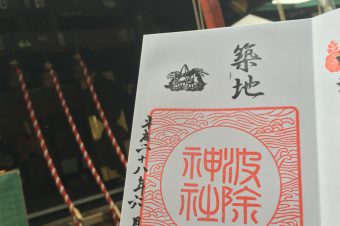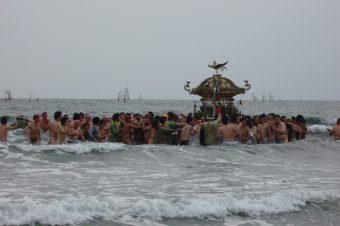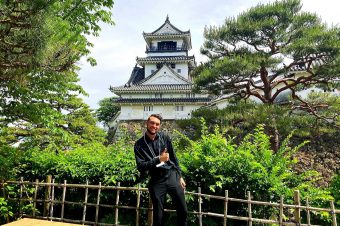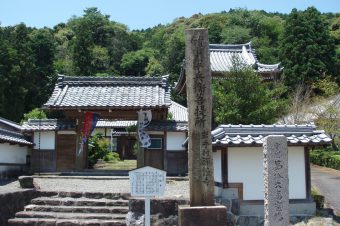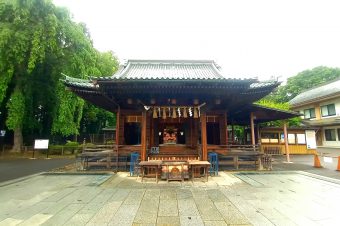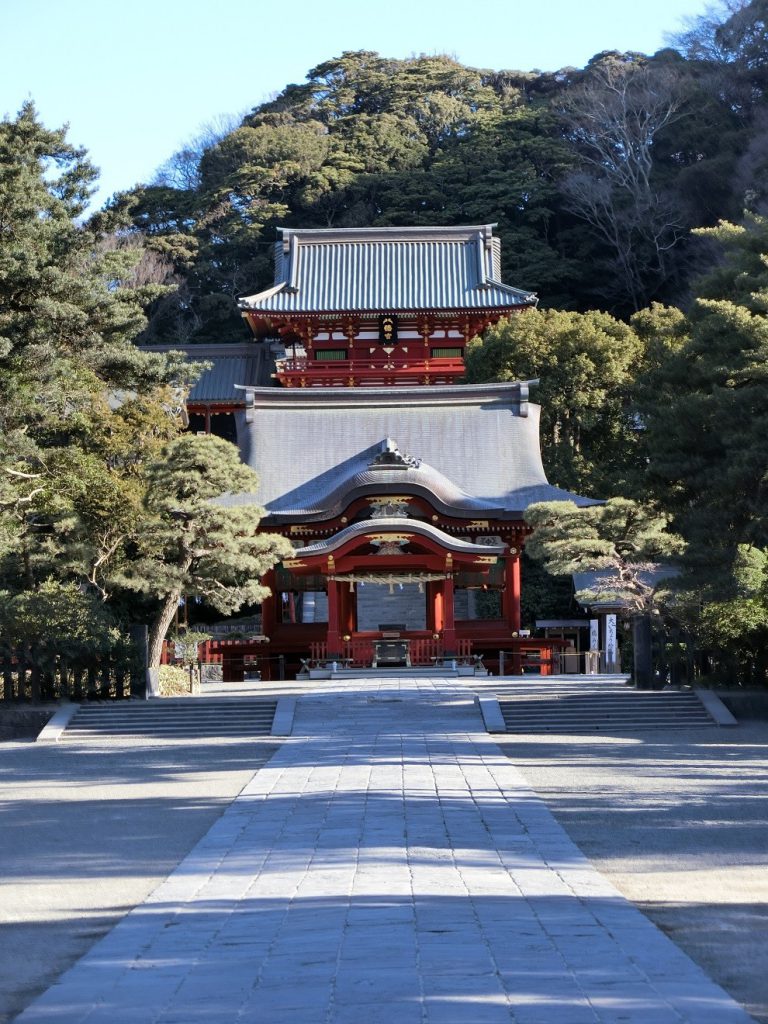
As a resident of Kamakura, it would be remiss of me not to talk about Tsurugaoka Hachiman as the first of a series of articles about Kamakura. This shrine is the abode of the patron deity of the Minamoto Clan and therefore also Kamakura itself. Revered as a military deity, most of Japan’s historical samurai lords, such as Lord Hideyoshi Toyotomi and Lord Ieyasu Tokugawa, have offered their prayers here before heading off to military campaigns. You may recall Lord Kuranosuke Oishi from the article about Sengakuji temple and the Akou Incident. On his way to Edo (now Tokyo) to direct the revenge attack on Minster Kira, Lord Oishi made the side trip to Kamakura to pray for success at Hachiman Shrine.
However, since so many excellent guidebooks are out describing the shrine, I am not going to talk so much about the shrine itself, but how you can walk along Kamakura’s main boulevard and see how Hachiman Shrine, history and Nature combined to create the city as it exists today.
Just a little bit about the history of Hachiman Shrine. The shrine you see perched on top of the bluff is not the shrine’s original location. It actually started out near Kyoto as Iwashimizu Hachiman Shrine. In 1063, Lord Yoriyoshi Minamoto moved the shrine to Kamakura. However, not to its current location. Original Kamakura Hachiman Shrine (currently called Yui Wakamiya Shrine)
was a small affair, located right next to the beach. When Lord Yoritomo Minamoto established his headquarters in Kamakura in 1180, he started the process to move the shrine to its present location atop a bluff overlooking his capitol city. The old location is now a branch shrine catering mainly to people who live in its immediate neighborhood. I usually pay my New Year’s respects at the old location rather than braving the crowds and hour long (or longer) waits at the main location. Same deity, different mailing address. Incidentally, all but one of the pictures in this column were taken during the New Year’s holiday 2017.
This is what Yui Wakamiya Shrine looks like. This picture was taken on New Year’s Day 2017, when my wife and I stopped by to pay our respects to the deity. The main building is only about the size of a shed. Normally, there is no staff onsite, except for January 1-3 for locals to pay their New Year’s respects. The main shrine sends over some people to open an office for people to buy this year’s omamoris, and sets up a booth where people can place last year’s omamoris to be burned according to custom. (One should NOT repeat NOT just throw an omamari away!)
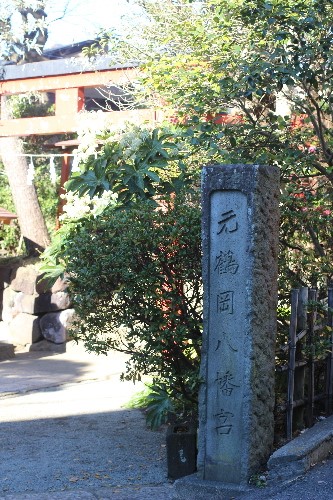
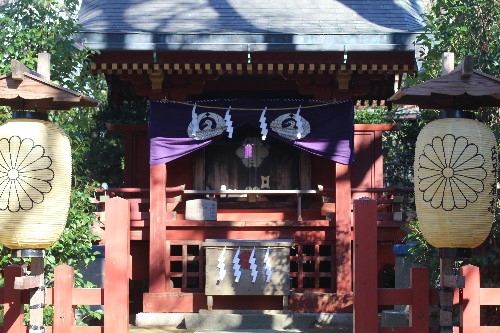
Okay, back to talking about the main Hachiman Shrine. Exit Kamakura Station via the East Gate and head out to Wakamiya Oji (Young Prince Boulevard). Lord Yoritomo ordered this road to be constructed to appeal to the gods for a safe delivery of his first child. Hachiman Shrine is to your left. However, please turn right and walk towards the shore, staying on the same side of the boulevard as the station. I’d like you to see the location of the original First Torii Gate. Walk under the railway bridge and you’ll be able to see the First Torii Gate about 300 yards away. Keep on walking towards the First Torii. It is situated on top of a small rise so when you get alongside it, you’ll finally be able to see the ocean. However, that isn’t original location of the First Torii. Turn back towards Hachiman and start walking again. Go under the pedestrian bridge, cross the crosswalk and stop in front of the fast food restaurant. In the small grassy area on your right you’ll see a circle marked in stone and a corresponding memorial. (You’ll probably have to peek around some bicycles locked to the surrounding railing while the bike owners eat burgers.) There is a corresponding circle on the other side of the street. These stone circles mark the foundation of the original First Torii, which was built right next to the beach. By the way, the memorial refers to the original First Torii as the “Large Torii on the Beach.”
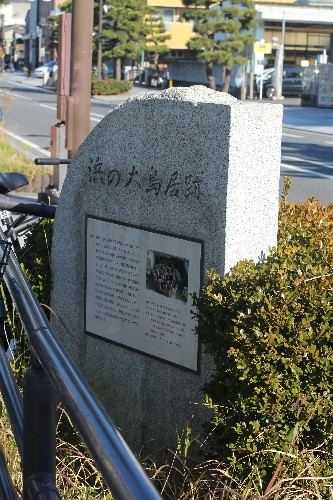
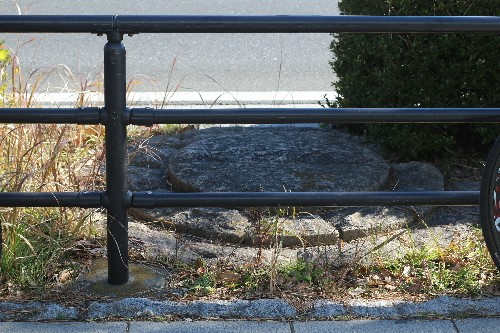
You might think, “but the beach is so far away!” True today, but not way back in 1180. Take a look at this model of Kamakura as it looked during the Kamakura Shogunate (1192-1333).
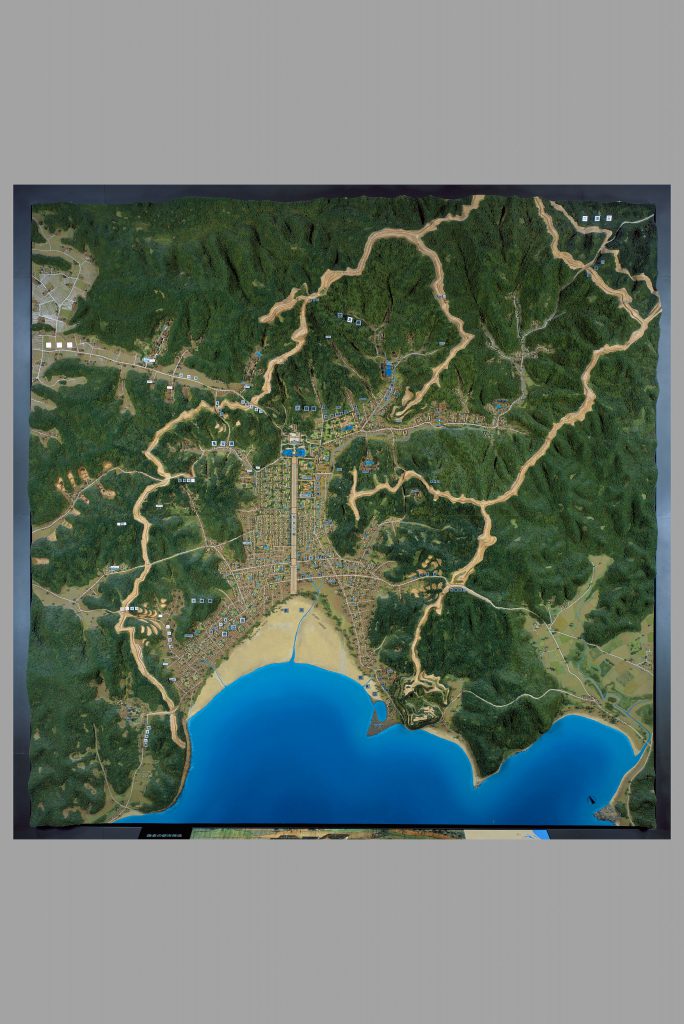
See how far inland the beach comes when compared to today? Ocean dynamics have since altered the coastline. You see, to build and support Lord Yoritomo’s capitol city (estimated to be five times more densely populated than it is today), the amount of commerce which could come into the city via the seven hill cutouts was insufficient. A port was needed, so Lord Yoritomo had one constructed. At the bottom right hand area of the model, you can see a hook shaped object. That is Japan’s oldest artificial harbor, known as Wakae Jima. The breakwater changed the hydrography enough to cause massive sand dunes to build up on the beach. The current First Torii sits on what used to be a sand dune. As you can see, the sand dune built up high enough to obscure the view of the First Torii. I’ve never been able to find out for certain, but probably at some point during the history of Kamakura, some bureaucrat decided having a First Torii which could not be seen from the ocean was unsatisfactory, and had the gate shifted to its current location.
Here’s a picture taken from the pedestrian overpass, looking out toward the First Torii and ocean beyond. It clearly shows the upward slope leading up to the First Torii.
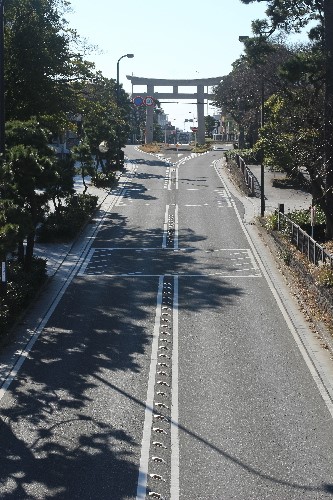
Head back towards Hachiman Shrine. When you get to the Second Torii, you’ll notice it is the start of a raised walkway. This is called the Dankazura and is the “Sacred Way” leading to Hachiman Shrine. The walkway was recently renovated and the walking surface is now fully paved, but until 2014 it was hard packed earth. Right at the very beginning of the walkway, walk from one side to the other and see how many steps it takes. Remember this number.
Second Torii, marking start and initial width of dankazura.
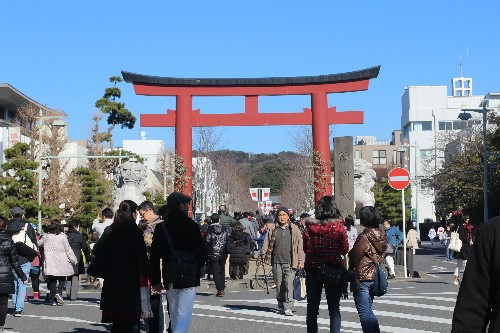
Walk along the Dankazura and you’ll get to the intersection just in front of the Third Torii. Again, see how many steps it takes to go from one side of the Dankazura to the other. Only about half as many steps as the beginning, right? Why might this be? I’ll tell you later.
There were too many people walking along the dankazura on New Year’s Day for us to be able to take a good picture of the shrine end of the walkway, so below is a picture of my wife during taken during a Kamakura Police Department event last year. We are approaching the end of the dankazura, you can see it is only wide enough for about four people to walk abreast. Clearly much narrower than the width of the dankazura at the beginning, as demarcated by the pillars of the Second Torii.

Cross the street, under the Third Torii, and into the shrine compound.
The Third Torii
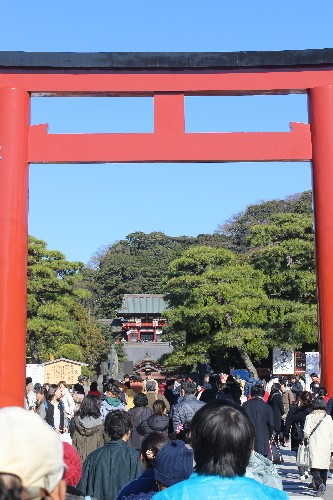
There are three bridges crossing a channel connecting two ponds. While the rounded bridge in the center is now closed off to pedestrian traffic, as a kid I spent many an enjoyable time scampering up one side and trying not to fall on my face going down the opposite side.
This last picture was taken on New Year’s Day, just past the rounded bride. The police were only letting people go up to the main building in waves. Facing about an hour’s wait, (and since we had already paid our respects at Yui Wakamiya Shrine), we gave up and decided to go off in search of some ice cream instead.
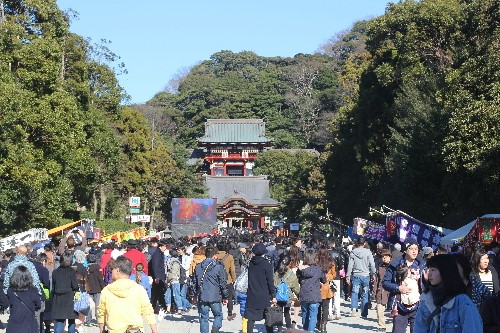
As you approach the steep steps leading up to the main building, the next structure you come to is the dance pavilion. Reputedly a very famous dance took place here back during the Kamakura Shogunate days. The dancer’s name was Shizuka Gozen, and she was the consort to Lord Yoritomo’s brother, Lord Yoshitsune. (Readers of this column may recall my wife currently portrays Lord Yoshitsune at various Kamakura events.) Captured and forced to dance, Shizuka Gozen defied Lord Yoritomo by singing a song praising her lover. The dance probably actually took place in another building, but this is a good story so why let the mere truth interfere with it. So, every year in April, during the Kamakura Festival, Shizuka’s dance is performed in the pavilion. I will cover Shinto marriage ceremonies at Hachiman Shrine in detail for a later edition of this column.
Okay, back to the shrine proper. From the dance pavilion area, climb up the steep steps to the main shrine building. When you get to the top of the steps, turn back around and look back over the city. You can clearly see the ocean, correct? This is because there is a city ordinance prohibiting the construction of buildings more than four stories high. Mere humans must not interfere with the Gods’ view, after all. There is one exception, but that department store was constructed during the heyday of Japan’s postwar reconstruction, before the ordinance was passed. (IMPORTANT SAFETY NOTICE: It is quite dangerous to walk down those steep steps. There are no handrails. On either side of the main building is a handrail equipped stairway, using either of these stairways is much safer than trying to walk down the main stairway.)
Okay, back to why the width of the Dankazura differs between the start and the end of the walkway. There are two theories, one artistic and one military. First, the artistic reason. Notice how the Dankazura extends out towards the ocean, with its sides perfectly parallel. If you think about it, though, if the sides were constructed perfectly parallel to each other, the Dankazura would seemingly get narrower as distance from point of view increases. The divergent design beautifully offsets this phenomenon.
Next, the military reason. Keep in mind the Kamakura Shogunate had only a loose hold on power. Lord Yoritomo had to be prepared to repel any attacks. Should the attackers come from the shore, the now convergent design of the Dankazura would throw off the estimation of distance. Enemy soldiers would be within effective arrow range of the defending forces while thinking they were still safely distant. Know the terrain, as Sun Tzu says, so Lord Yoritomo modified the potential battlefield to put terrain in his favor.
Your call as to which theory you prefer. Being of a military background myself, naturally I prefer the military reason. Perhaps, however, Lord Yoritomo decided to construct the Dankazura in this way for both reasons.
Finally, I urge you to turn back toward the shrine’s main structure and offer your respects to the Hachiman deity. Especially if you are any sort of samurai fan, because then you will know you are following in the footsteps of many legendary Japanese samurai warriors to include Lord Yoritomo Minamoto, Lord Hideyoshi Toyotomi, Lord Ieyasu Tokugawa, and Lord Kuranosuke Oishi. You’ll be in great company!
